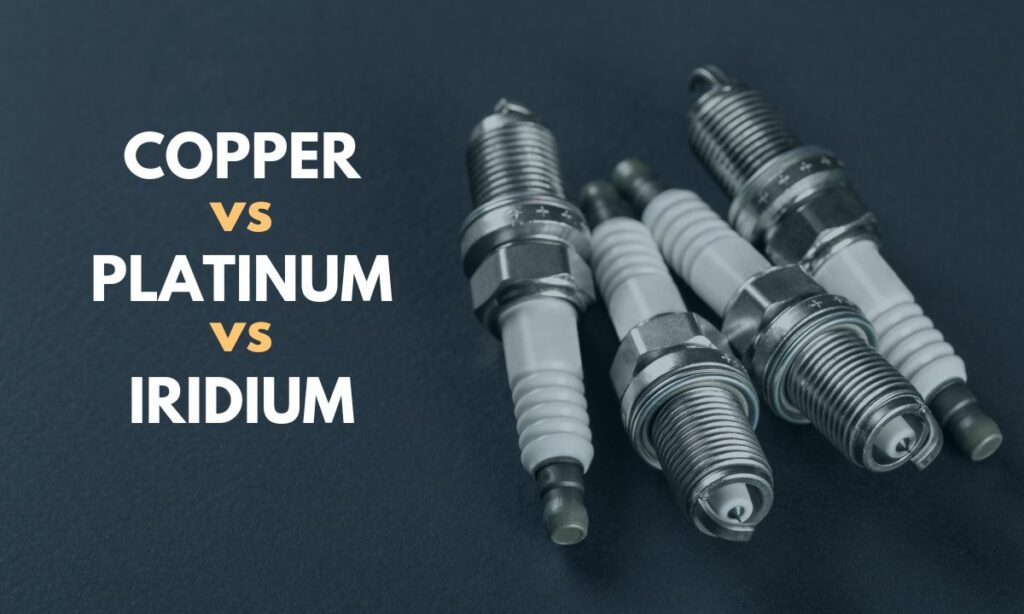Spark plug maintenance is a wee bit difficult. But a dicier thing is to pick the best spark plug type for your vehicle.
Based on the spark plug tip material, there are mainly 3 types:
- Copper spark plugs
- Platinum spark plugs (single and double)
- Iridium spark plugs
Which is better among these three spark plugs?
In terms of performance, iridium spark plugs are the best. Copper spark plugs are the cheapest spark plugs and are widely used. Platinum spark plugs act as a compromise between cost and performance.
That’s the short version. For a long and detailed version of these spark plug types and their comparison, let’s dig in.
#1. Copper spark plugs
Spark plugs with copper electrodes are called copper spark plugs. As simple as that. Nickel is usually added to copper to form an alloy that is more rust-proof.
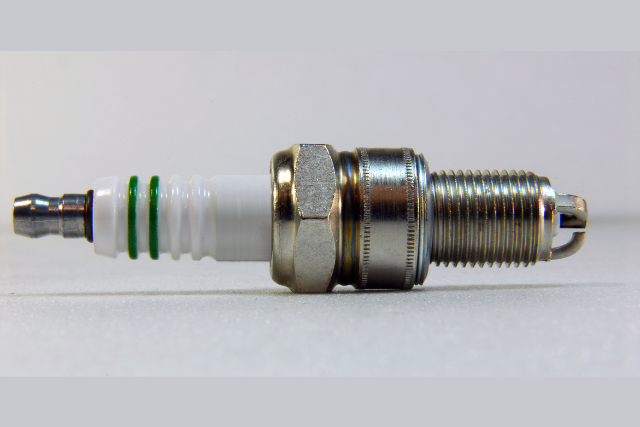
Copper spark plugs are the first spark plug type used in automobiles.
And they are still ruling the market. Copper spark plugs are still the widely used spark plug type in automobiles. But of course, the grip has been dwindling since the last decade.
The reason why copper spark plugs were so popular boils down to two main reasons. First, copper is cheap. Second, copper is an easily available material for manufacturers.
The low cost and ease of sourcing made copper a go-to material for spark plugs among the available options that could conduct heat and electricity.
But there are downsides as well.
Copper has a melting temperature of 1085 Celsius.
In general terms, this is a reasonably high melting point. But as a material for spark plug center electrodes? It’s pretty low. Spark plugs generate 20,000-volt electric spark and can get super hot. You expect a far higher temperature withstanding capabilities.
In addition, copper oxidizes fast to form a rust layer.
This is not at all desirable. To overcome this hurdle, Nickel is usually added to form an alloy. Other metal pieces are also used in the spark plug to overcome this low melting temperature. They are used to distribute the heat.
The resulting copper and nickel alloy is more rust-proof. But on the flip side, the material becomes softer and wears out fast.
Lifespan
Copper spark plugs last around 10,000 to 20,000 miles.
The best practice is to replace the spark plug for every 10,000 miles of distance traveled. In addition, check the copper spark plugs every 4000 to 5000 miles.
Why do copper spark plugs stop performing so early?
This can be because of worn-out electrodes, deposit formation, or insulator damage. But mostly, deposit formation.
Price
A typical copper spark plug will cost you around $2.5.
Even accounting for different versions and manufacturers, you would still get a copper spark plug in the range of $2 to $5.
I mean, if you ever see a copper spark plug costing $10, skip it. You can buy an iridium spark plug (the costliest of the lot) for that price.
If you are buying a set of spark plugs, then a set of 4 or 6 spark plugs should be in the price range of $10 to $20.
Pros and Cons
Copper spark plugs are low-cost and widely used. This has to do with their ease of sourcing for the spark plug manufacturers. In short, copper spark plugs are economical.
But there are downsides too.
Copper spark plugs cannot operate at high temperatures. Copper has a low melting point and if the spark plug gets too hot, it is a concern.
Next, adding nickel to copper makes it more rust-proof but at the same time, softer and wears out fast. Lastly, copper spark plugs don’t last long.
To summarize:
Pros
- low cost and economic spark plugs
- Easy to source and manufacture
Cons
- Cannot withstand extremely high temperatures
- Wears out fast
- Has a short life span and needs to be replaced early
#2. Platinum spark plugs
Spark plugs with platinum center electrodes are called platinum spark plugs.
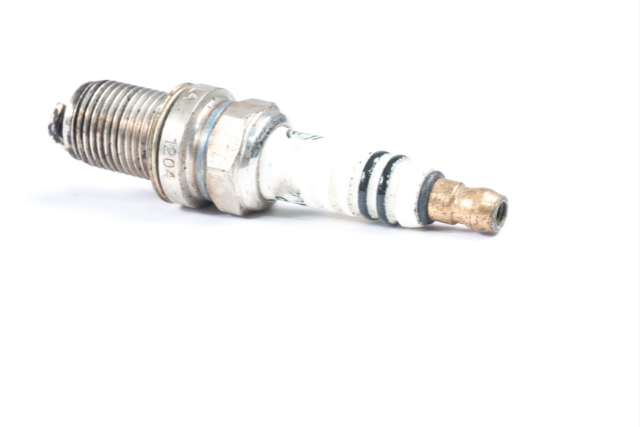
I know I know. The entire post on these different spark plug types hinges on which material is used as center electrodes. Still, if you skip to this section directly, I wanted you to know why a platinum spark is called a platinum spark plug. Back to the discussion.
Platinum spark plugs were developed as an improvement over conventional copper spark plugs.
Interestingly enough, platinum spark plugs provide the same if not slightly inferior performance when compared to copper spark plugs.
But platinum spark plugs do have a higher lifespan, better operating temperature, and low carbon deposit formation.
And they also last longer than copper spark plugs. Almost 3X times. They need replacing every 50,000 miles.
Platinum spark plugs also have better melting temperatures and hence, can operate at a higher temperature. A typical melting temperature of platinum is 1768 celsius.
Another better aspect of platinum spark plugs is they do not allow carbon deposits. The platinum coating on the electrodes prevents too much carbon deposit formation. This was a huge problem in copper spark plugs.
Lifespan
Platinum spark plugs usually last around 50,000 to 60,000 miles.
The best practice is to replace the spark plug every 30,000 miles. Plus, check the condition every 8000 to 10,000 miles traveled.
Platinum spark plugs last far longer than copper spark plugs. Almost 3X the lifespan.
Price
A typical platinum spark plug will cost you around $5.
If you are buying a set of spark plugs, then a set of 4 or 6 spark plugs should be in the price range of $20 to $50.
Single vs. Double platinum spark plugs
There is a distinction within platinum spark plugs. Single platinum spark plugs and double platinum spark plugs.
Single platinum spark plugs are the regular spark plugs we refer to. There is spark generation by the spark plug one time during each compression stroke of a combustion cycle.
Double platinum spark plugs, on the other hand, are unusual.
In double platinum spark plugs, there is spark generation both in the compression stroke as well as in the exhaust stroke of the engine combustion cycle.
Basically, two sparks per combustion cycle. These spark plugs are used in certain lawnmowers and generators.
For more details on double platinum spark plugs, you can check out our post here.
Pros and Cons
As discussed in previous sections, platinum spark plugs have a good lifespan. They last longer than copper spark plugs.
Platinum spark plugs can also withstand high temperatures. They can operate at a far higher temperature when the spark plug is hot compared to conventional spark plugs.
Lastly, they do not allow carbon deposit formation easily.
But, for all their improvements, platinum spark plugs perform poorly when compared to copper spark plugs.
Pros
- Higher lifespan (lasts longer)
- Withstands high temperatures
- Does not allow carbon deposit formation easily
Cons
- Slightly poor performance than copper spark plugs
- Costlier than copper spark plugs
#3. Iridium spark plugs
Spark plugs with iridium center electrodes are called iridium spark plugs.
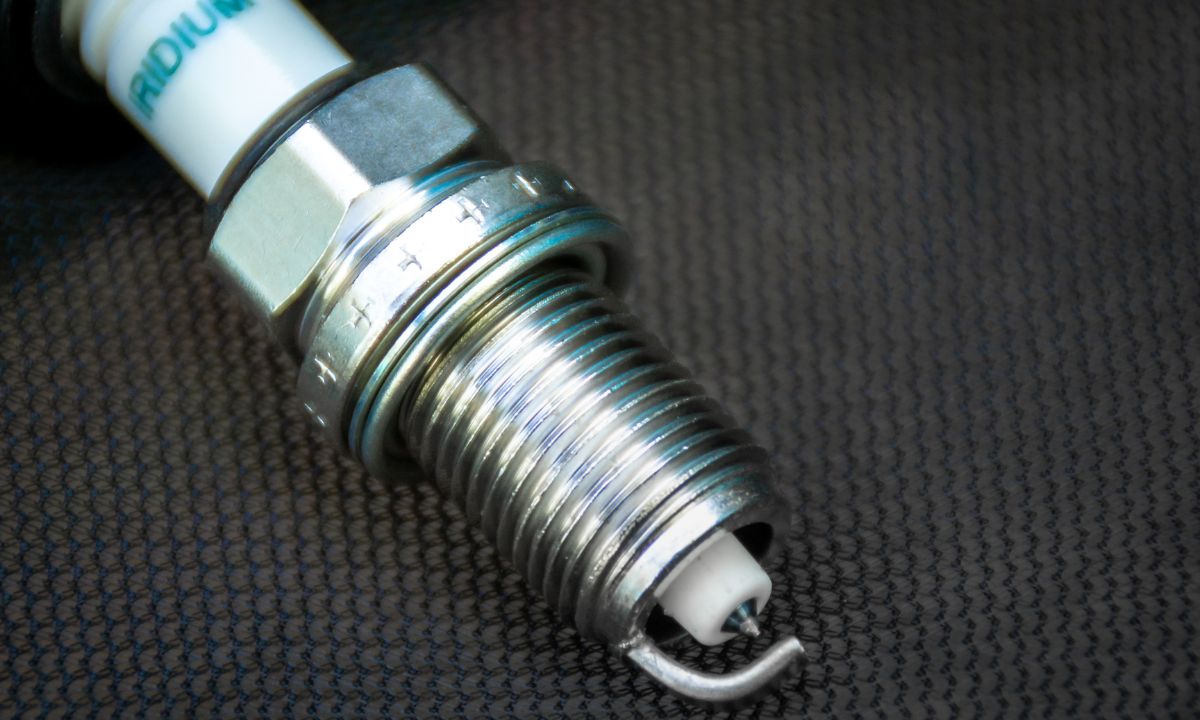
Iridium spark plugs are the best spark plugs in terms of performance. They perform better, have a higher life span, and can withstand far higher temperatures than the other two.
The melting temperature of Iridium is 2446 Celsius.
This is far higher than that of both copper and platinum. As a result, iridium spark plugs can operate under far high temperatures in the engine combustion chamber.
Iridium spark plug also requires less current to create the spark and ignite the fuel in the combustion chamber. Making it the best spark plug in the market.
Lifespan
Iridium spark plugs can last as long as 100,000 miles.
This is the best part. Iridium spark plugs have a great life span. You need to change the spark plug for every 100,000 miles. Far higher than copper and platinum spark plugs.
Price
Iridium spark plugs are costly.
A typical iridium spark plug costs around $7 to $10.
They are at least 4X costlier than copper spark plugs. I will say the extra cost is worth it. But again the tradeoff still depends on you.
Pros and Cons
You can notice the improved performance whenever you shift from a copper spark plug to an iridium spark plug. The acceleration is quick, smooth, and faster.
Iridium spark plugs can also withstand high temperatures. Their high melting points make them operate at a far higher heat range than copper or platinum spark plugs.
The icing on the cake? a high life span. You only need to change the iridium spark plug every 100,000 miles. Far higher than copper and iridium spark plugs.
The downside of all these amazing qualities is the cost. Typically, iridium spark plugs 4X of copper spark plugs.
Pros
- High performance and improved firing efficiency
- Great lifespan
- Can withstand high temperatures
Cons
- The costliest spark plug on the market
Copper vs Platinum vs Iridium Spark Plugs: Comparison
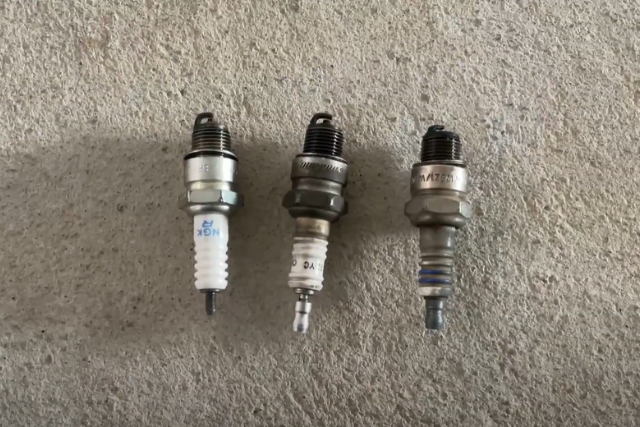
Now that we know about each of these spark plugs, let’s compare them on specific parameters:
Power and Performance
Iridium spark plugs are the best in terms of performance. The power generated in the engine is at its optimum with iridium spark plugs compared to the other two.
Surprisingly, between copper and platinum, copper spark plugs provide better performance than platinum spark plugs. Platinum spark plugs, despite being considered superior to copper spark plugs fall short in performance.
Winner: Iridium spark plugs
Lifespan
Iridium spark plugs have the best lifespan, followed by platinum spark plugs. Copper spark plugs have the lowest life span and need frequent replacement.
| Spark Plug Type | Approximate Lifespan |
|---|---|
| Copper | 30,000 miles |
| Platinum | 50,000 miles |
| Iridium | 100,000 miles |
Winner: Iridium spark plugs
Operating Temperature
Again, the iridium spark plug is the most well-equipped to handle high operating temperatures in the engine.
Between platinum and copper, platinum spark plugs fare well and can withstand higher temperatures.
Copper has a low melting point. Usually, nickel is added to copper to increase its heat resistance and decrease rust formation.
Winner: Iridium spark plugs
Deposit Formation And Wear
Both platinum and iridium do not allow carbon deposit formation easily. But, the same cannot be said about copper spark plugs.
Even wear resistance. Both platinum and iridium spark plugs have good wear resistance. Copper spark plugs, on the other hand, wear out at a much faster rate.
Winner: Platinum and Iridium spark plugs
Cost
With great performance comes great cost.
It must not be surprising that iridium spark plugs are the costliest ones. Followed by platinum spark plugs.
Copper spark plugs are the cheapest type of spark plugs out there. Copper is easy to source. Manufacturers can get it readily available. Hence, the low cost of copper spark plugs.
Winner: Copper spark plugs
Which spark plug is the best?
Iridium spark plugs are the best type of spark plugs. They deliver superior performance and have a higher life span.
However, iridium spark plugs are costly. Not many are eager to go for them.
Few still prefer copper spark plugs because of their low cost. And a few go for platinum as a compromise between cost and performance.
There is no one size fits all.
That brings us to the point:
Always check for the spark plugs recommended in the owner’s manual.
If your vehicle is recommended to have iridium spark plugs, you just can’t downgrade to a copper or platinum spark plug.
On the other hand, if the manual recommends a copper spark plug, it probably is best to go for copper spark plugs rather than upgrading to a platinum or an iridium one.
Before you go…
Here are a few more spark plug posts for you:
